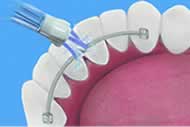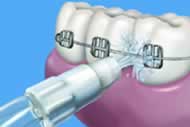Cleaning Dental Braces
Dental braces can create oral health problems such as gingivitis and decalcification (white marks), which lead to more serious issues.
- Gingivitis is the earliest sign of gum disease. It appears as red, swollen, and shiny gums that bleed easily. It is caused by plaque that irritates the gum tissue and causes an infection.
- Decalcification affects your tooth enamel, causing white spots or lesions on your teeth. It is caused by a combination of plaque and acid production after you eat and drink. Decalcification is impossible to correct, so prevention is critical.
You can minimize or prevent oral health problems caused by dental braces with good dental and orthodontic care.



Brushing Your Teeth and Flossing with Braces
To remove plaque, you should brush around all parts of your dental braces and all of the surfaces of your teeth. Ideally, you should brush after every meal or snack. If you can’t brush right away, rinse your mouth well with water.
A manual toothbrush works well if you use it correctly. But when you have brackets, wires, and other hardware in your mouth, you may find it easier to use a sonic toothbrush. Watch your toothbrush head for wear. Due to the brackets and other hardware, you will need to replace the brush head more often.
You also need to floss to remove the plaque that your toothbrush cannot reach.
Make Flossing With Braces Easier
An easy and effective way to remove plaque around dental braces and improve gum health is to use a Waterpik Water Flosser with the Orthodontic Tip. It is clinically proven more effective than dental floss for people with braces. Learn more about how to floss with braces using a Waterpik water flosser.
The Orthodontic Tip is designed with a tapered brush on the end to help remove plaque that sticks to the brackets and between your teeth. It also helps flush out the bacteria and food debris from around teeth and under the gums.
Why should I use a Waterpik when I have braces?
Using a Waterpik when you have braces can be highly beneficial for your oral health. Braces can make it difficult to clean certain areas of your mouth, especially around brackets and wires where food particles and plaque can easily get trapped. Failing to properly clean these areas can increase the risk of developing tooth decay, poor gum health, and other oral health issues.
A Waterpik uses a stream of pressurised water to remove food particles and plaque from hard-to-reach areas in your mouth, making it an effective tool for cleaning around braces. It can help flush out debris from between your teeth, braces, and wires, reducing the risk of developing cavities, gum inflammation, and bad breath. Additionally, Waterpik can help massage your gums, which can promote healthy blood flow and improve gum health. It can also be an alternative to traditional flossing, which can sometimes be difficult and uncomfortable for people with braces.
Overall, using a Waterpik in conjunction with brushing and regular dental check ups can help keep your teeth and gums healthy during orthodontic treatment, making it a worthwhile investment for anyone with braces.
Will it hurt to use a Waterpik when I have braces?
Using a Waterpik when you have braces should not be painful, but you may experience some discomfort or sensitivity, especially if you are new to using it.
Here are a few things to keep in mind to ensure a comfortable and effective Waterpik experience:
- Start with the lowest setting: If you are new to using a Waterpik or have sensitive teeth and gums, start with the lowest pressure setting and gradually increase the pressure as you get more comfortable.
- Use the orthodontic tip: When using a Waterpik with braces, it is important to use an orthodontic tip that is specifically designed to clean around brackets and wires. This tip is designed to be gentle and effective, so you shouldn't experience any discomfort.
- Angle the tip correctly: To avoid discomfort, make sure you angle the Waterpik tip correctly when cleaning around your braces. Aim the tip directly at the gum line, holding it at a 90-degree angle to the tooth surface.
- Be patient: It may take a few tries to get the hang of using a Waterpik with braces, so be patient and take your time. With practice, you should be able to clean your teeth and braces comfortably and effectively.
- If you experience any pain or discomfort while using a Waterpik, stop immediately and consult with your orthodontist or dentist. They can offer additional guidance on how to use a Waterpik safely and effectively with braces.
Other Tips for Dental Braces Care
Using fluoridated toothpaste or adding a fluoride rinse to your routine can help prevent white spots (decalcification) and decay. It's also important to continue your regular dental check-ups during orthodontic treatment.

